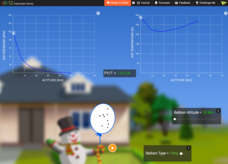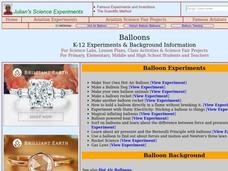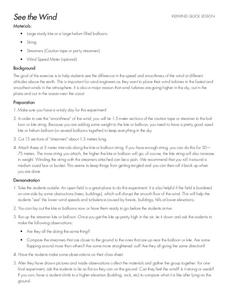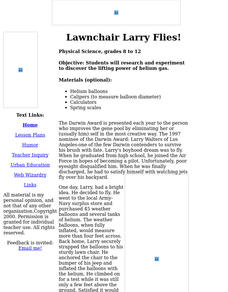CK-12 Foundation
Runaway Balloon
When a child lets go of a helium balloon, what happens to it? Does it float all the way to space? The simulator allows pupils to experiment on party balloons and weather balloons under different conditions to see what happens to them in...
NASA
Make a Planetary Exploration Balloon
Balloons aren't just for parties! An inquiry-based lesson explores the idea of using balloons for space exploration. Learners become engineers as they attempt to control the ascent and descent of a helium balloon using different masses.
Curated OER
Art: Hot Air Balloon Replicas
Students investigate the science behind hot air balloon flight. In a lecture and demonstration, they observe how helium-filled balloons are affected by the wind. Using basic household items such as newspaper, paper cups, and balloons,...
DiscoverE
Pilot a Balloon
Balloons will go where you want them to. Young pilots first add paper clips to a balloon to make it neutrally buoyant. They then use cardboard to steer the balloon in different directions, taking air pressure into account.
Curated OER
Helium Balloon Race
Students determine the force of a helium balloon that allows it to rise a specific distance. In this helium lesson students calculate the amount of paper needed to construct a weight and determine the density of a piece of...
Curated OER
Balloons
Students explore the different types of balloons. In this materials lesson students can complete several experiments including building their own hot air balloons, making balloon animals and experimenting with static...
Curated OER
Bag Balloons
Students demonstrate that heat can change air. They determine that hot air rises. Students construct a working model of a hot air balloon. They understand that there are two ways that a balloon can rise: it can (1) be filled with a...
Lions Clubs International Foundation
Mindful Self-Management Exercise: Managing Stress
An exercise offers young scholars a coping skill to manage stress or other strong emotions. Learners identify the emotion, focus on how their body feels physically, then pretend they are holding a balloon over their heads, blow their...
Curated OER
Gases Lighter and Heavier than Air
Students explore the concept of air density. For this air density lesson, students fill balloons with helium and carbon dioxide. Students determine which gases are heavier or lighter than air.
Curated OER
Latex Helium Balloons: Any Alternatives?
Students discuss the latex balloon release controversy and review suggested alternatives to the latex balloon.
Curated OER
Fun with Balloons
Fifth graders design their own hot air balloon. In this science instructional activity, 5th graders investigate how factors like weight and sizes affect a balloon's lifting power. They also write math problems based on facts...
Curated OER
THE TRAVELS OF BABAR: An Adventure in Scale :Building a Model Hot Air Balloon
Students encounter basic facts about helium and hot air. They compare the weight and size of different materials. Students work collaboratively in teams. They create their own model balloon.
Curated OER
Name That Gas!
Young scientists discover that air is a mixture of different gases - mainly nitrogen and oxygen. The properties of some of the other gases found in oxygen are listed in a table, then learners must decide which one of those gases is...
Curated OER
See The Wind!
Students learn about wind at different altitudes above the earth. In this wind lesson plan, students use kites or balloons with attached streamers to observe the wind speed, wind turbulence and shear at different elevations. Students...
Curated OER
1st Grade - Act. 16: Dancing Mice
First graders creating mouse attached to a helium balloon, and dance around to the sound of some fun music.
It's About Time
The Rear End Collision
Did you know one in every four car crashes are rear end collisions? The lesson explains what happens to your neck when you are involved in a rear end collision. Scholars experiment and apply Newton's Second Law of Motion.
Curated OER
See the Wind
Students explore alternative energy sources. In this wind energy lesson, students will investigate the difference in the speed and smoothness of wind at different altitudes above earth. Students will use kites, helium balloons,...
Curated OER
Why Do Hot Air Balloons Float?
In this Charles' Law worksheet, students solve 8 gas law problems where the pressure is constant and the volume varies directly with the temperature.
Curated OER
Breaking News English: Police to Charge Balloon Boy Father
In this English worksheet, students read "Police to Charge Balloon Boy Father," and then respond to 47 fill in the blank, 7 short answer, 20 matching, and 8 true or false questions about the selection.
PBS
Hands-On Engineering Challenges to Bolster Your Electricity, Sound, and Force Units
Need some activities to go along with your unit? A collection of hands-on activities from PBS offers opportunities to add to your electricity, sound, and force units. The electricity activities revolve around building a...
Curated OER
How Can You Tell One Clear Gas From Another?
Fifth graders perform experiments to determine the identity of an unknown gas sample. In this chemistry lesson, 5th graders fill balloons with air, oxygen, hydrogen, and carbon dioxide. They use mass and reactivity to identify the gases.
Curated OER
Lawnchair Larry Flies!
Students research and experiment to discover the lifting power of helium gas.
Curated OER
Puppets
Fifth graders explore the art of puppetry. They design and create their own puppets using helium balloons. They create the three dimensional features for their selected mammals and felt shirts. They perform an impromptu play citing...
Curated OER
Solids, Liquids and Gases - Part 2
Students experiment with balloons, soda water and raisins to find out about the states of matter. In this solids, liquids and gases lesson plan, students complete a group activity with balloons to recognize the state of matter in...

























